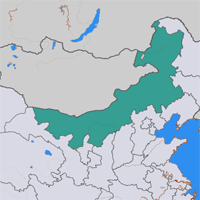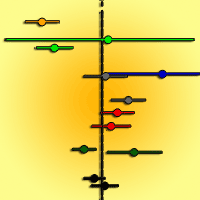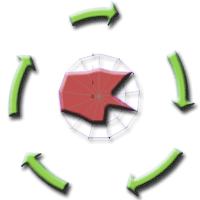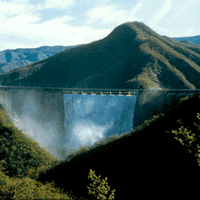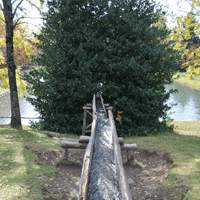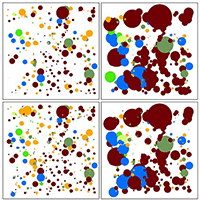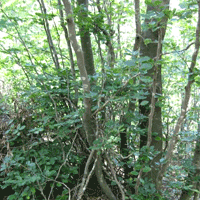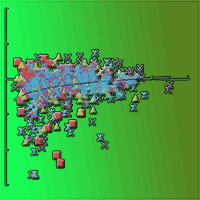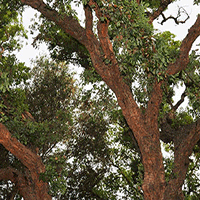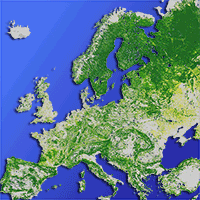
Forest functions and space: a geohistorical perspective of European forests
Roberto Pilli (1) , Andrea Pase (2)
iForest - Biogeosciences and Forestry, Volume 11, Issue 1, Pages 79-89 (2018)
doi: https://doi.org/10.3832/ifor2316-010
Published: Jan 31, 2018 - Copyright © 2018 SISEF
Review Papers
Abstract
The history of man has been linked to the history of wood since prehistoric times and because the forest is the main place where this resource is available, forest spaces are also directly linked to the evolution of human society. The objective of this paper is to analyze the historical evolution of the functions assigned by humans to forests, highlighting how they affect the production of space from a diachronic perspective. Focusing our attention on some European countries, we highlight that although historically, wood production was the most important function provided by wooded lands, other functions were also attributed to forests. The awareness of these functions emerged when an overexploitation of forest resources produced a lack of a specific service. When these services corresponded to a societal demand, they produced welfare benefits for the society, which were recognized as forest functions. Thus even the functions evolved in time according to the evolution of societal needs. Evaluating when and how each societal demand emerged, and consequently the moment each function was recognized, is an essential prerequisite even for a more accurate interpretation of current forest management practices. Not only is the temporal dimension of forest functions relevant, so is the spatial scale, which may differ considerably between them, ranging from the specific forest area and its owner for the productive function; to the catchment area and its inhabitants for the protective function; to a potentially larger area for the cultural and biodiversity function; and to the entire globe for the carbon-retention function. The strict, and sometimes competing, interactions between these functions may also be recognized in the production of space, which evolved in time according to the evolution of the corresponding societal needs. A forest parcel assigned to a productive function is a material space, marked in the field by colored signs, but it may also be virtually represented by a forest model or be part of some protected area. But this picture would change if, instead of looking at the present, we consider the past and the different sensations and representations concerned with forests. These complex interactions, between different functions and spatial dimensions, justify the need to balance a segregative management system with a wider, multi-functional integrated approach. What has emerged from our study is that to reach this difficult equilibrium, it is useful to consider the production processes of these forest spaces. Through this analytical approach, we can understand the interactions occurring over time between the evolution of the demands expressed by society and the main changes occurred on the forest landscape.
Keywords
Forest Functions, Services, Production of Space, History, Sustainable Forest Management
Authors’ Info
Authors’ address
European Commission, Joint Research Centre, Directorate D - Sustainable Resources - Bio-Economy Unit, Ispra, VA (Italy)
Università di Padova, Dipartimento di Scienze Storiche, Geografiche e dell’Antichità, Padova (Italy)
Corresponding author
Paper Info
Citation
Pilli R, Pase A (2018). Forest functions and space: a geohistorical perspective of European forests. iForest 11: 79-89. - doi: 10.3832/ifor2316-010
Academic Editor
Luca Salvati
Paper history
Received: Dec 15, 2016
Accepted: Nov 21, 2017
First online: Jan 31, 2018
Publication Date: Feb 28, 2018
Publication Time: 2.37 months
Copyright Information
© SISEF - The Italian Society of Silviculture and Forest Ecology 2018
Open Access
This article is distributed under the terms of the Creative Commons Attribution-Non Commercial 4.0 International (https://creativecommons.org/licenses/by-nc/4.0/), which permits unrestricted use, distribution, and reproduction in any medium, provided you give appropriate credit to the original author(s) and the source, provide a link to the Creative Commons license, and indicate if changes were made.
Web Metrics
Breakdown by View Type
Article Usage
Total Article Views: 54652
(from publication date up to now)
Breakdown by View Type
HTML Page Views: 44378
Abstract Page Views: 3732
PDF Downloads: 5393
Citation/Reference Downloads: 27
XML Downloads: 1122
Web Metrics
Days since publication: 2860
Overall contacts: 54652
Avg. contacts per week: 133.76
Citation Metrics
Article Citations
Article citations are based on data periodically collected from the Clarivate Web of Science web site
(last update: Mar 2025)
Total number of cites (since 2018): 15
Average cites per year: 1.88
Publication Metrics
by Dimensions ©
Articles citing this article
List of the papers citing this article based on CrossRef Cited-by.
References
La Méditerranée et le Monde méditerranée à l’époque de Philippe II [The Mediterranean and the Mediterranean World in the Age of Philip II]. IV Edition, Librarie Armand Colin, Paris, France, pp. 160. [in French]
Gscholar
Paides e Parthenoi. Primo volume [Paides and Partenoi. First volume] (Alessandri A, Cremonesi C eds). Editori Riuniti, University Press, Roma, Italy, pp. 518. [in Italian]
Gscholar
Le leggi veneziane sul territorio, 1471-1789: boschi, fiumi, bonifiche e irrigazioni [Venetian laws on the territory, 1471-1789: forests, rivers, land reclamation and irrigation]. Signum, Limena (Padova), Italy, pp. 255. [in Italian]
Gscholar
Boschi della Serenissima: storia di un rapporto uomo-ambiente [Woods of the Serenissima: story of a man-environment relationship]. Arsenale, Venezia, pp. 132. [in Italian]
Gscholar
Storia del pensiero forestale [History of forestry thought]. Rubettino, Catanzaro, Italy, pp. 543. [in Italian]
Gscholar
Montanari per scelta. Indizi di rinascita nella montagna piemontese [Mountaineer for shoice. Signs of rebirth in the Piedmont mountains]. FrancoAngeli, Milano, Italy, pp. 112. [in Italian]
Gscholar
Studii di archeologia forestale [Forestry archeology studies]. Firenze, 1965. Reprint from, Corpo Forestale dello Stato, Roma, Italy, pp. 600. [in Italian]
Gscholar
Guns, germs, and steel. The fates of human societies. WW Norton and Company, New York, USA, pp. 480.
Gscholar
Proposal for a Regulation of the European Parliament and of the Council on the inclusion of greenhouse gas emissions and removals from land use, land use change and forestry into the 2030 climate and energy framework and amending Regulation No 525/2013 of the European Parliament and the Council on a mechanism for monitoring and reporting greenhouse gas emissions and other information relevant to climate change. European Commission, Brussels, pp. 37.
Online | Gscholar
From the Apennines to the Alps: colonization genetics of the naturally expanding Italian wolf (Canis lupus) population. Molecular Ecology 16: 1661-1671.
CrossRef | Gscholar
Proceedings of the 3rd Expert Meeting on Harmonizing Forest-Related Definitions for Use by Various Stakeholders. Food and Agriculture Organization of the United Nations, Rome (Italy) 17-19 Jan 2005, pp. 148.
Gscholar
Parco Nazionale del Gran Paradiso [Gran Paradiso National Park]. In: “Parchi e Riserve Naturali in Italia” (Bianchi E, D’Inella M, Laurini M eds), Touring Club Italiano, Milano, Italy, pp. 253. [in Italian]
Gscholar
Space as a key word. In: “Spaces of Global Capitalism: Towards a Theory of Uneven Geographical Development” (Harvey D eds). Verso, London-New York, pp. 115-148.
Gscholar
Integrative approaches as an opportunity for the conservation of forest biodiversity. European Forest Institute, Freiburg, Germany, pp. 284.
Gscholar
Forests policy analysis. European Forest Institute, Springer, Dordrecht, The Netherlands, pp. 334.
Gscholar
La production de l’espace [The production of Space]. Anthropos, Paris, France, pp. 485. [in French]
Gscholar
EUwood - Real potential for changes in growth and use of EU forests. Final report, Hamburg, Germany, pp. 160.
Gscholar
Eine Mathematische Untersuchung über den Aufbau des Plenterwaldes [A mathematical analysis of the structure of a Plenterwald]. Schweizerische Zeitschrift für Forstwesen 84: 33-46, 88 - 103: 124-131. [in German]
Gscholar
Ecosystems and human well-being: a framework for assessment. Millennium Ecosystem Assessment, Island Press, Washington DC, USA, pp. 266.
Gscholar
Ecosystems and human well-being: current state and trends. Findings of the condition and trends. Working group. Millennium Ecosystem Assessment, Island Press, Washington DC, USA, pp. 155.
Gscholar
The lever of riches: technological creativity and economic progress. Oxford University Press, Oxford, UK, pp. 368.
Gscholar
L’uomo e la foresta [Man and Forest]. Meltemi, Roma, Italy, pp. 168. [in Italian]
Gscholar
The history of the countryside: the full fascinating story of Britain’s landscape. JM Dent and Sons Ltd, London, UK, pp. 415.
Gscholar
Codice Forestale Camaldolese. Le radici della sostenibilità. Primo Volume [Camaldolese Forest Code. The roots of sustainability. First Volume]. Ministero delle Politiche Agricole, Alimentari e Forestali, Osservatorio Foreste, INEA, Collegium Scriptorium Fontis Avellanae, Fano, Italy, pp. 250. [in Italian]
Online | Gscholar
Einleitung zu den Ideen zu einer Philosophie der Natur [Introduction to ideas for a philosophy of nature]. In: Preti G (1967). L’empirismo filosofico e altri scritti [Philosophical empiricism and other writings]. La Nuova Italia, Firenze, Italy, pp. 1-65.
Gscholar
Seeing like a State. How certain schemes to improve the human condition have failed. Yale University Press, New Haven and London, UK, pp. 435.
Gscholar
Ministerial conference on the protection of forests in Europe 2011. Forest Europe Liaison Unit, Madrid, Spain, pp. 344.
Gscholar
Ministerial conference on the protection of forests in Europe 2015. Forest Europe Liaison Unit, Madrid, Spain, pp. 314.
Gscholar
Leggi di variazione dei parametri della foresta disetanea normale [Laws of variation of the parameters of the uneven-aged normal forest]. Italia Forestale e Montana 3: 105-116. [in Italian]
Gscholar
I rovereti di pianura della Serenissima [Oaks woodlands of the Venetian plain]. CLEUP, Padova, Italy, pp. 159. [in Italian]
Gscholar
Foreste in forma. La gestione sostenibile nei boschi delle Marche [Forests in good shape. Sustainable management in the Marche forests]. Regione Marche, Comunitá Montana Alto e Medio Metauro e Partners, Arti Grafiche Stibu, Urbania, Italy, pp. 164. [in Italian]
Gscholar
Fauna e caccia sulle Alpi [Wildlife and Hunting in the Alps]. Athesia, Bolzano, Italy, pp. 184. [in Italian]
Gscholar

